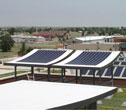Sustainability and energy efficiency are buzz words in the roofing industry. Highly reflective roof systems, vegetative coverings and roof-mounted photovoltaic systems are in the headlines every day. Although these sustainable and energy-efficient features are valid, they should be secondary to a properly installed insulation layer within a roof system.
NRCA continues to recommend proper design and installation of an insulation layer because an underinsulated building envelope is not energy-efficient. And from a building owner's perspective, installing high R-value roof insulation should be a priority for energy efficiency at the roof level. The roofing industry should continue to promote insulation and energy efficiency, as well as traditional methods of weatherproofing.
A proper design for an insulation layer is two or more layers of insulation with staggered and offset joints and a cover board layer to separate the primary thermal insulation layer from the membrane. Mechanical fasteners only should be used to secure the bottom layer(s) of insulation, not the top layer.
Benefits of proper design
Because heat flows from warmer to cooler areas, a significant amount of heat can leave a building through an inadequately insulated roof assembly during heating season (winter) and enter a building through an inadequately insulated roof assembly during cooling season (summer). Therefore, a building with an inadequately insulated roof assembly requires extra energy to compensate for natural heat flow and energy loss.
So why is it necessary to have two layers of insulation? Why should the joints be offset and staggered? Why is a cover board needed?
The NRCA Roofing Manual: Low-slope Membrane Roof Systems—2011 discusses the benefits of proper insulation design. Additionally, experience and research reported in "Thermal Evaluation of the Effects of Gaps Between Adjacent Roof Insulation Panels" by James E. Lewis, which is based on the proceedings of the Department of Energy's and Oak Ridge, Tenn.-based Oak Ridge National Laboratory's Workshop on Mathematical Modeling of Roofs, have shown a minimum of two layers of rigid insulation can provide the following benefits to low-slope roof systems:
- Increased roof system thermal performance. Research shows using only a single layer of insulation may reduce a roof system's energy efficiency by as much as 10 percent. The bottom layer of insulation should be mechanically fastened or adhered depending on the roof deck type. The second layer of insulation should be adhered to the bottom layer. NRCA recommends the joints in the second layer be offset from the joints in the base layer to reduce thermal transmittance and membrane fatigue. When a loose-laid, ballasted, single-ply membrane system is installed, both layers of insulation may be loose-laid.
- Reduced thermal loss. Gaps between single-layer insulation board joints can provide a path for airflow, heat transmission and condensation. A multi-layer insulation system can help eliminate "thermal shorts" at board joints.
- Reduced thermal bridging. Metallic mechanical fasteners are good conduits for thermal bridging, especially if they include large metal washers. NRCA suggests mechanical fasteners not extend through all insulation layers. Additional research from "A Heat Transfer Analysis of Metal Fasteners in Low-Slope Roofs," a paper published in ASTM STP 959, "Roofing Research and Standards Development," concluded mechanical fasteners penetrating through rigid board roof insulation may reduce thermal resistance 3 to 8 percent.
- Reduced potential for membrane buckling, ridging and splitting. The continuous vertical joint that is present in single-layer insulation boards is eliminated if the second layer's board joints are offset.
Cover board
To clarify, a single layer of thermal insulation with a cover board meets NRCA's recommendations for a properly designed insulation layer within a roof system. NRCA suggests using an appropriate cover board with all types of membrane roof systems because a roof assembly's performance often is enhanced when a cover board is installed.
For example, a cover board can increase a roof membrane's impact and puncture resistances. A cover board also separates incompatible materials, such as a PVC membrane and polystyrene insulation, and can provide protection from construction traffic.
Cover board types include fiber-reinforced gypsum, glass-faced gypsum, mineral fiber, perlite and wood fiber. When a cover board is used, the joints should be staggered from the joints in the insulation layer below.
R-value
NRCA recommends designers specify thermal resistance (R-value) and thickness of insulation for the roof assembly based on in-service R-values rather than according to an advertised R-value. For instance, a designer should specify "provide 5 inches of polyisocyanurate" rather than "provide an R-value of 25." This ensures bids are based on equivalent insulation thicknesses.
For example, assume a roof system over a steel deck is specified to have an R-value of 25 with no additional installation requirements. The likely solution is to mechanically fasten a single layer of 4-inch-thick polyisocyanurate with an advertised R-value of 25 (or 6.25 per inch). (There are several manufacturers who offer a 4-inch-thick polyisocyanurate board with an advertised R-value of 25.)
However, in 2011, NRCA updated its recommendation for polyisocyanurate's in-service R-value. NRCA now recommends using an in-service R-value of 5 per inch thickness in heating conditions and 5.6 per inch thickness in cooling conditions. According to NRCA, in a heating climate, a single layer of 4-inch-thick polyisocyanurate would only have an in-service R-value of 20.
Additionally, according to the research, the single layer of insulation will reduce the R-value up to 10 percent, and the mechanical fasteners will reduce the R-value up to 8 percent.
For ease, let's assume an overall R-value loss of 15 percent based on these two issues. We apply this 15 percent loss to the in-service R-value (20), not the manufacturer-advertised R-value (25). A 15 percent loss would further reduce the example roof's R-value to 17, significantly lower than what was intended by the designer or specifier. The roof would fall short of expectations and could invalidate energy efficiency and energy savings estimates. This is why NRCA recommends a designer specify insulation thickness, not R-value.
If the example roof is to have an in-service R-value of 25, the designer could specify three layers of thermal insulation—two 1 1/2-inch-thick layers and one 2-inch-thick layer of rigid polyisocyanurate insulation boards. A 1 1/2-inch-thick polyisocyanurate board typically is needed as the bottom layer for uplift resistance and fire ratings.
According to NRCA, polyisocyanurate's in-service R-value is 5 in a heating climate, so the roof would need 5 inches of insulation at an R-value of 5 per inch to achieve an overall R-value of 25. Following NRCA's recommendations, the first layer of polyisocyanurate should be mechanically attached, and the subsequent layer(s) should be adhered with board joints offset and staggered. Inclusion of an adhered cover board completes the insulation layer. The additional inch of insulation installed in multiple layers instead of one layer is the best method to ensure a long-lasting, quality insulation layer with the expected level of thermal insulation.
There are, of course, other combinations of insulation thicknesses that will achieve an R-value of 25 and meet uplift- and fire-resistance requirements. And, as always, the roof system design needs to satisfy the requirements for the appropriate approvals for wind and fire resistance based on the building type, use and location.
Installation matters
In addition to determining in-service R-value, a key component of a sustainable and energy-efficient roof system is durability, which includes a properly designed and installed insulation layer. The following will help ensure an insulation layer is installed successfully and the roof system lasts a long time.
Insulation needs to be properly supported. A majority of roof decks, such as concrete or wood decks, provide continuous support. For steel roof decks, flute direction and width need to be appropriate for the insulation type. Rigid insulation board's orientation should accommodate the insulation's fastening pattern as well as other roof system components.
On steel roof decks, rectangular rigid insulation boards should be placed with their longer edges supported on the deck's top flanges. Insulation boards directly attached to a steel roof deck should not cantilever over the open flutes.
Steel deck panels can be slightly out of alignment or out of square when installed. Edges of steel decks typically are overlapped to provide structural continuity, but this generally adds incremental amounts to the flutes' overall spacing. At some point, the insulation's edge might begin to cantilever off the top flanges of the steel deck panels. The insulation boards need to be cut so the edges properly realign to miss the roof deck's flutes. Additional time and effort are required to correct the issues created by such steel deck installation; however, if not corrected, these issues can create weak spots in the insulation layer, possibly resulting in a loss of membrane support and localized ponding or membrane damage.
The long term
A properly designed and installed insulation layer is a critical part of a roof assembly's ability to achieve energy efficiency and overall sustainability. Designers are encouraged to spend the time to appropriately design and specify a roof system's insulation layer, and building owners should understand the long-term effects of the design and installation of their roof system's insulation layer relative to sustainability and energy efficiency. The extra time and care taken during design and installation can achieve significant, long-term benefits for a building and its owner.
James R. Kirby, AIA, is NRCA's associate executive director of technical communications.



